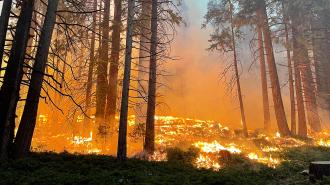The survival of a stand of towering sequoia trees — some pushing over 3,000 years old — in California’s Yosemite National Park may represent a case study in the power of the controlled burn.
As climate change and decades of poor forestry management leads to massive accruals of dry overgrowth, wildfires are availing themselves to an unprecedented amount of fuel to become faster, hotter, and more brutal than before.
Even the ancient sequoias, evolved to depend on fire to thrive, are having a difficult time coping.
“The fires they’ve evolved to withstand are very, very different than the fires of today,” Yosemite forest ecologist Garrett Dickman told NPR.
But in a nice symmetry between the ancient trees and ancient ways, controlled burns, like the kind Native American tribes have been using to manage land for centuries, helped save the park’s Mariposa Grove, experts told NPR.
The survival of 3,000 year-old sequoias may be a case study for controlled burns.
Fighting fire with fire: With all apologies to the famed idiom, you can indeed fight fire with fire.
Wildfires are a natural part of a forest’s lifecycle and are crucial to the health of the ecosystem. Without them, trees struggle for limited resources, and fire-dependent species suffer. Wildfires open up the seed-filled cones of old-growth sequoias, a key to their reproduction; the venus flytrap needs its competitors burned away to gain access to the direct sunshine it requires.
A controlled burn — designed for the specific area’s needs — will not only help the forest stay healthy, but also prevent more intense wildfires. Go too long without a burn, and the old overgrowth that fuels the fire can build up to unnaturally high levels, unleashing a hell even evolution is not prepared for.
Native American tribes, like those in Northern California, understood the importance of a controlled burn.
Saving the sequoias: The sequoias in the Mariposa Grove survived where others did not because of controlled burns.
“The fire entered the grove and luckily we had 50 years of prescribed fire history” in Mariposa, Dickman told NPR. “So it could have been a very different outcome if we hadn’t been preparing for this fire for decades.”
As the Washburn Fire barreled down on Mariposa, it ran into something of a roadblock: a piece of forest where the overgrowth, dried to kindling by climate change, was no longer so prevalent. Lacking this excess fuel, it slowed its spread and became less intense, allowing firefighters to move in and battle the blaze up close, moving the sequoias out of harm’s way.
As climate change and decades of poor forestry management leads to massive accruals of dry overgrowth, wildfires are becoming faster, hotter, and more brutal than before.
Similar groves of old-growth sequoias without management did not survive their fires, and the forest immediately surrounding the grove was an inferno — after not being burned for over a hundred years.
“The flame lengths we saw in the interior of the [Washburn] fire were dozens of feet, if not hundreds of feet” Dickman told NPR.
“That’s a lot of heat to put branches into the air. Firefighters can’t really engage when, you know, there’s 125 tons of fuel on fire.”
Snuffing it out: As the Guardian reported, the Forest Service, scientists, and ecologists back in the day considered the Native Americans’ use of the controlled burn to be “primitive” and “essentially destructive,” deciding instead to snuff out wildfires wherever and whenever they could.
“They said if we suppress all these fires, we end light burning, we will have great new forests,” Stephen Pyne, a fire historian, told the Guardian. “And we did – we had so much great new forest that we created a problem.”
By the 1960s and 1970s, when Mariposa Grove’s burns began, the services realized the error of their ways, and the controlled burn once again became part of forest management, although it was applied unevenly.
Californians particularly still fear the flames, while southeastern states dominate prescribed burns. Florida does prescribed burns on 2.1 million acres each year. California, which is more than twice the size, intentionally burns just 125,000 acres — even though the state has a backlog of 20 million acres that need forest thinning or burning.
A controlled burn — designed for the specific area’s needs — will not only help the forest stay healthy, but also prevent more intense wildfires.
Beyond the counter-intuitiveness of fighting fire with fire, there is of course a true potential danger: the controlled burn may become out of control, as recently happened in New Mexico, which led to a 90-day safety review.
Still, despite this risk and the negative impacts of smoke, there is a building consensus that controlled burns are crucial to curtailing the most horrific wildfires.
That includes turning to the collected knowledge and experience of the people who have been doing this on a timescale even the sequoias recognize, as federal, state, and non-government organizations now work with Native American experts. (California recently passed a law affirming Indigenous people’s right to manage their land with fire.)
“It’s selective manipulation through millennia to foster a more resilient, diverse and productive landscape,” Frank Lake, a US Forest Service research ecologist with Karuk heritage and Yurok family, told the Guardian.
We’d love to hear from you! If you have a comment about this article or if you have a tip for a future Freethink story, please email us at [email protected].





